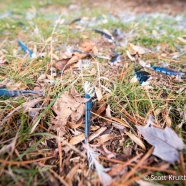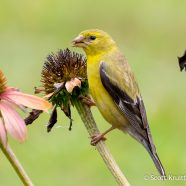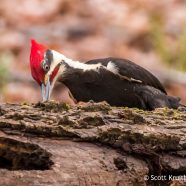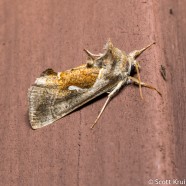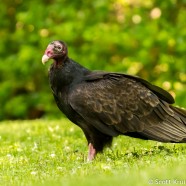Blue Jay End
Speaking of hawks, it appears that I came upon the final remains of a Blue Jay (Cyanocitta cristata) this morning with this very large pile of feathers strewn about under a small tree. The raptor sat here in a relatively quiet spot and plucked its prey, leaving little else behind. I would guess that an accipiter – probably a Cooper’s Hawk, but possibly a Sharp-shinned – took this Blue Jay hours earlier. It may not be the most enjoyable find for some, but it is the cycle of life in nature, and that hawk has to try to survive, too. Scott Kruitbosch Conservation & Outreach...
Read MoreAmerican Goldfinch Eating Coneflowers
Finally! It took me a while, but here is photographic proof of why you should not cut any dead coneflower heads. This American Goldfinch was chowing down and enjoying it so much that it ignored me. I frequently hear and occasionally see them dining like this, but never when my camera is near or I am close to them. Many plants end up producing delicious seeds in their…less aesthetically pleasing stages…and should be left alone as a meal for many forms of wildlife, or even just to propagate their species. Scott Kruitbosch Conservation & Outreach Coordinator
Read MorePileated Woodpecker (Dryocopus pileatus)
Let’s switch gears from the little migrant birds to the big resident birds with this Pileated Woodpecker (Dryocopus pileatus) as photographed last week during its breakfast. This meal, while being obviously tasty and delicious, also provides us a lesson in forest and yard management. Most of the time Pileated Woodpeckers can be found eating at dying, dead or fallen trees like this one as they hammer away for ants and various insects associated with decaying wood. If we removed all of the rotting wood from the forest or our yards what would they have to eat? Not much! If you can safely...
Read MoreCelery Looper (Anagrapha falcifera)
Here are a couple of shots of the relatively tame and relaxed Celery Looper (Anagrapha falcifera). While it actually blended in to this paint job relatively well, imagine it on a dead or decaying leaf, the rotting organic material curling up into similar patterns with a perfect color match. Sometimes I feel that I should be checking for moths more in their native habitats, right on their host plants instead of at convenient lights or by setting up ultraviolet sources…but that would take far longer and be much less productive with how well some of them can hide, and I do feel good about...
Read MoreTurkey Vulture
During a late afternoon on a lovely day last week I did a double take as I found an unexpected bird on the lawn – a Turkey Vulture! It had discovered a dead Eastern Chipmunk only moments earlier and was preparing to do its job. I was with my Shetland Sheepdog, Zach, who had not seen the bird over the slight hill in the lawn. I walked back to him, bent down and told him to look at this bird as I pointed. He eagerly glanced around and spotted it, eyes widening and slowly creeping towards it out of curiously and intrigue despite my cautioning. He held at this position, head forward,...
Read More



